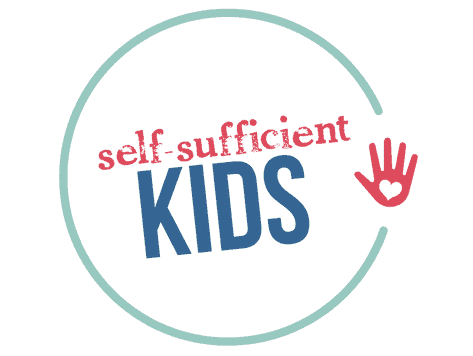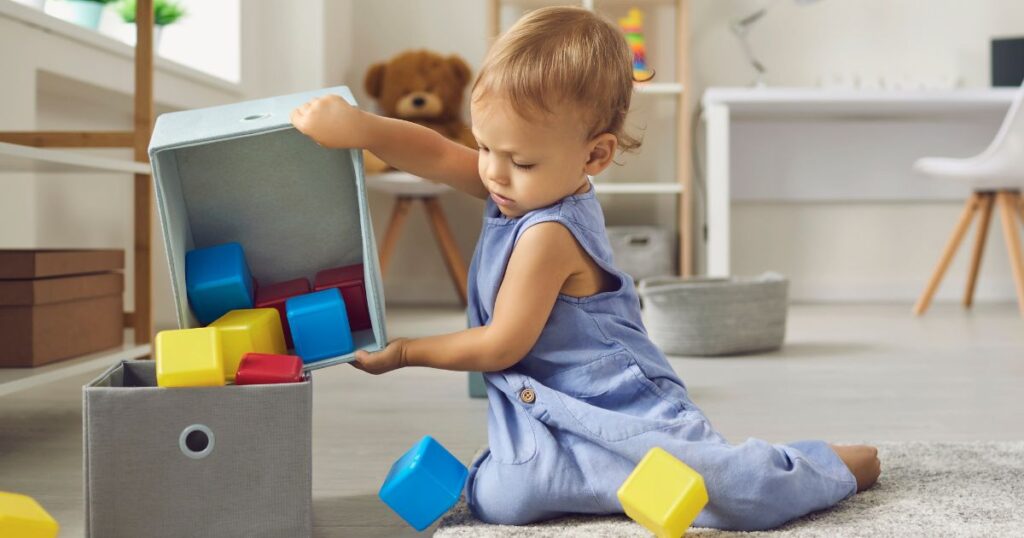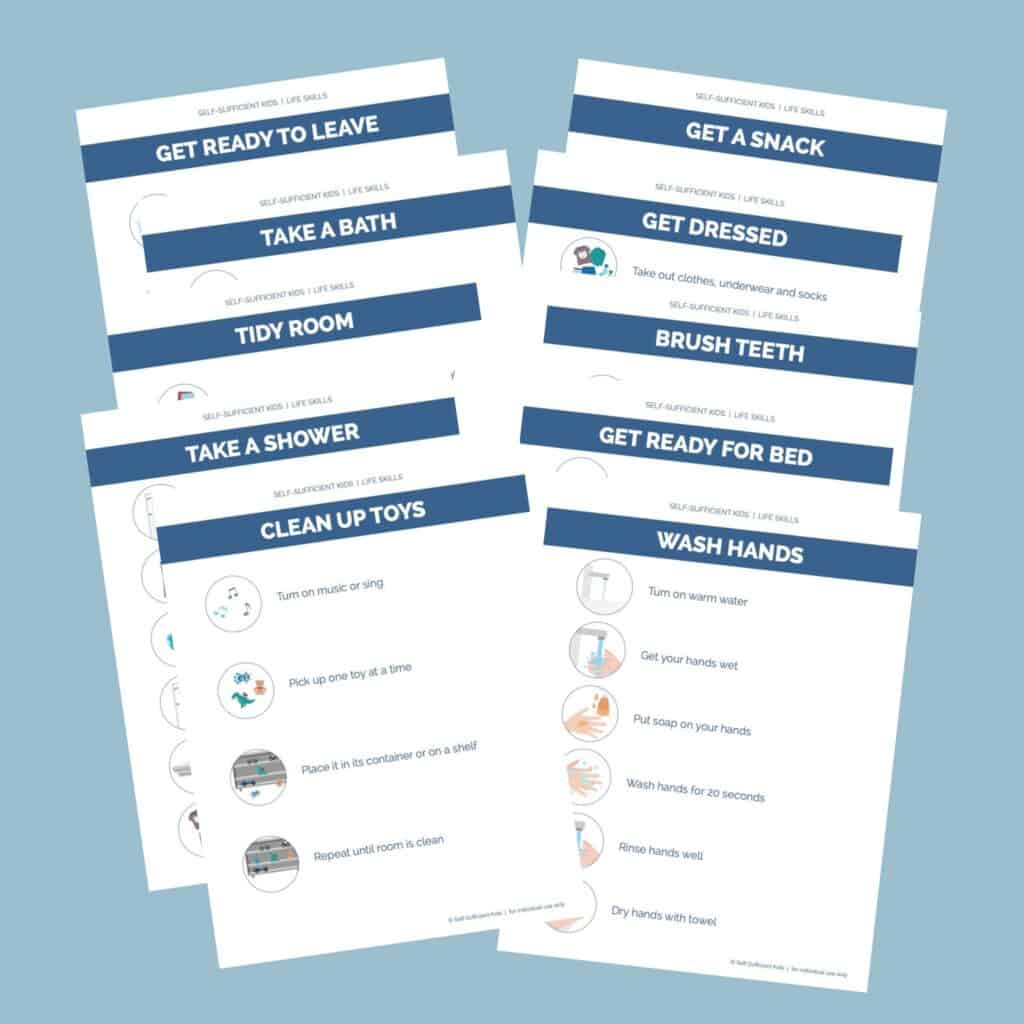Why Kids Need Time for Independent Play (and How to Make it Happen)
Children (and parents!) benefit from kids having time for independent play. Here’s when to start and how to encourage your child to play alone.
** As an Amazon Associate I earn from qualifying purchases. **
Maybe you remember experiencing it when you were younger or have seen it happen with your child.
That magical moment where children get lost in their play – so focused on what they’re doing that the world around them fades away.
Perhaps it’s building a castle with Legos or Magna-Tiles that’s held their attention.
Or imaginary play-acting that they’re fairies living in a magical world.
Psychologists refer to this as a “state of flow” – a moment a person, in this case, a child, is completely absorbed in an activity for its own sake. They’re immersed in the present moment without even thinking about it.
While playing with our children is a wonderful way to help them build cognitive, language, and self-regulation skills, the benefits of independent play are just as important for their development.
But what exactly is independent play, and how can you encourage your child to have (and enjoy) independent playtime? The following advice can help:
What is independent play?
Independent play is when children play on their own without an adult or other children involved. It’s a moment when a child has the opportunity to focus on an activity all by themselves.
Of course, very young babies and toddlers will still need an adult within reach to ensure safety. At this age, children may also be experiencing a developmental stage where they don’t feel comfortable being separated from a parent or parents. So it’s important not expect to this playtime to last very long (see chart below).
As kids get older and are more developmentally ready, they can play in a separate room from their parents (that is childproofed for safety). And, eventually, older children can begin to play outdoors on their own, assuming that it is safe to do so.
Why is independent play important to children?
As mentioned previously, when children play independently, they’re given the opportunity to experience a state of flow.
This state of flow allows kids to enhance their creative thinking, attention span, and problem-solving skills as they test and retest different theories and scenarios about their world or the materials they’re working with.
For example, a child playing with blocks may try to determine just how high they can stack them. Eventually, the tower will fall, giving them information (albeit basic) about physics.
Another child may enjoy spending time alone in their bedroom, play-acting different roles like a teacher or singer. While kids benefit from imaginary play with other children, they also benefit from entering their own make-believe world. This type of play serves the purpose of helping kids try to make sense of the world around them.
Kids receive many benefits from independent play. And parents, of course, also benefit from the few minutes or hour of time they get to themselves as their child gets absorbed in their activity.
Here are a few key ways independent play will benefit your child, no matter their age:
- Encourages independence: This may seem obvious – that independent play encourages independence – but some children need to be given opportunities to understand that time alone, away from their parents and in their own company, can feel safe and comfortable.
- Fosters creativity: When children are presented with limited open-ended toys and materials during their alone time, they’re able to explore their individual creativity and build upon it.
- Boosts imagination: Similar to creativity, kids will find new ways to explore their imagination and play with their toys without outside influence.
- Prevents boredom: Once your child learns how to entertain themselves and come up with their own ways to explore and create, they won’t be coming to you every few minutes saying they’re bored. They can rely on themselves to have fun.
- Develops patience: When your child makes a mistake or struggles with something during their independent play, they’ll eventually (and with your encouragement) learn to rely on themselves to problem solve to try again until they get it right.
At what age should a child play independently?
It’s never too early or too late to start independent play with your child. Even children younger than six months can be given the opportunity to experience a little independent playtime, albeit for a short period and with a parent within close reach.
As kids move into toddlerhood, you can continue to encourage independent play and the earlier this special time is established into your routine the better since it will simply become a natural part of the day.
But beware that very young kids may have difficulty separating from a parent for too long. It’s important not to push your child to spend time alone if they aren’t ready – this could cause them to despise their alone time. Instead, gentle encouragement or even doing different tasks side-by-side can help kids ease into independent play.
How long should I expect my child to play alone?
The length of time your child plays alone really depends on their age and level of development. You know your child best, but here’s a good rule of thumb:
- Young newborn: 5-10 minutes once or twice a day.
- First few months: 10-20 minutes twice a day.
- Independent sitter: 15-30 minutes twice a day.
- Crawler: 30-45 minutes at least once a day.
- 15-20 months: Up to 60 minutes in a kid-proofed closed area or room.
- 18 months and older: 60-90 minutes in a kid-proofed closed area or room.
- Toddlers, preschoolers, and older children: 60-90 minutes a day.
Keep in mind that these times are estimates. Some children will be able to play longer, while for others it may be shorter as they get used to playing alone.
And, of course, there will naturally be times when your child won’t be able to have as long of solo play as usual due to external circumstances like a sibling’s activity or a holiday. Working independent playtime into your normal daily routine will benefit your kids, but missing that time every now and then won’t be detrimental.
How to encourage toddlers and preschoolers to play independently
We all know how difficult it can be to get toddlers and preschoolers to do anything. So if you haven’t already established independent playtime with your young child, the idea of getting your child on board may seem daunting. Here are a few tips to warm your child up to the idea:
Be positive
Your attitude toward independent play will have a big impact on how your child perceives it. Children are perceptive and will know if your true motive is only to have time alone (however much you really need it!). When it’s time for your child to play independently, position it as a fun opportunity for them to explore on their own and make sure they are set up for success before leaving the room (see tips below). And certainly, avoid coming across as annoyed if your child finishes their independent play before you expected them to. That will only make them less inclined to participate next time.
Create a safe play space
Babies and young children in particular will need a childproof and safe space to play. That way, you can feel comfortable leaving them on their own – not worried that they will swallow something they shouldn’t or stick a metal object in an outlet, for example. Using child gates, like these, can help keep young children contained in a specific area and protect them from getting into objects that could cause them harm.
Limit their toy choices
If you find your child isn’t able to play alone for very long, it’s possible that they’re overwhelmed by the number of toys and activities available to them. Work with your child to choose a handful of things for them to focus on during their independent playtime. It’s also a good idea to put overstimulating toys away and have your child play with open-ended toys like blocks, figurines, and art materials. Anything your child can explore in creative ways will help them build skills, use their imagination, and get them lost in a moment of “flow”. Rotating toys every now and then will also keep independent play fresh and exciting.
Don’t go too far away
Children naturally feel safer and more comfortable when they know a parent is easily accessible. It’s best to stay within eye/earshot of babies and at least within earshot of toddlers. Older kids can begin to play in areas of the house with more distance from you and older kids can play independently outside (assuming your yard is safe and you’re in a safe neighborhood).
Avoid interrupting
Comments like “Great job stacking those blocks!” or “Wow, what a cool painting!” may seem encouraging at the moment, but will take your child out of their flow and quickly turn solo time into time with you. Giving kids the opportunity to focus and get deep into their play will make the time more rewarding for both them and you.
Try to keep it consistent
Like most things when raising young children, consistency is key! By making independent play a part of your daily routine, your child will come to expect it and with your guidance and support view it as a normal activity. The more regular it is, the easier it will be for your child to embrace their solo time.
Keep the focus on your child, not on you
All parents deserve time alone. After taking care of your children or working all day, it’s natural to feel like you’d like to find a way to have some time alone.
But if the main motivation for kids’ independent playtime is simply to give you space, your child will be attuned to your motives and may possibly resist spending time alone. Instinctively, kids need and want their parent’s attention and tend to resist anything that would diminish that attention.
Instead, focus on the benefits your child receives with independent play and let that guide your communication. They may not instantly be convinced since many children need time to warm up to the idea, but focusing on what they gain, rather than on what you gain, provides the greatest potential for making independent playtime a success for everyone.
See related:
How to Encourage Imaginary Play (and Why it’s So Important)
Giving Our Kids the Gift of Doing Nothing
How Quiet Time Can Fuel Your Child’s Creativity (And Help Your Sanity)
Why Kids Need Risky Play to Thrive
Help guide your young child through everyday tasks with these Simple Directions for Young Children Cards. Each card serves as a reminder of how to carry out a task and allows children to eventually take on tasks independently. Click here to learn more.
What to do next…
1. Subscribe to Self-Sufficient Kids’ email list.
Like what you read here and want to learn more? Every Thursday I’ll send you one parenting tip about raising self-sufficient kids and creating the peaceful relationship you yearn to have with your child. Click here to sign up.
2. Take one of my quizzes!
Find out if you’re raising a self-sufficient kid (click here) or if you’re doing too much for your kids (click here). At the end of each quiz, you’ll be asked to provide your email address to see the results.
3. Get your kids started on chores.
Learn how to get your child started on chores (& keep them motivated + avoid power struggles) by enrolling in my Get Your Kids Successfully Started on Chores course. Click here to learn more and sign up.

About Kerry Flatley
Hi! I’m Kerry, the mother of two girls and a certified parent educator. I believe it is possible for parents to have a supportive, loving, and warm relationship with their kids while raising them to be independent and ultimately self-sufficient. Over the years, I’ve read numerous books and articles that support this belief and I’ve put these ideas into practice with my own kids. Read more about me and Self-Sufficient Kids here.



